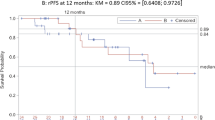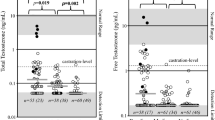Abstract
Objective: To evaluate the efficacy of bicalutamide vs cyproterone acetate in preventing PSA flare (as a surrogate for tumour flare) for patients requiring luteinizing hormone-releasing hormone (LHRH) analogue therapy for prostate cancer.
Patients and Methods: In this pilot study, 40 men were randomized 1 : 1 to bicalutamide 50 mg o.d. or cyproterone acetate 100 mg t.i.d. 5 days prior to goserelin acetate and continued for 21 days thereafter. PSA, luteinizing hormone (LH), follicle-stimulating hormone (FSH) and testosterone were obtained before treatment and on days 6, 8, 10, 16, 21 and 28. Primary end point was PSA. Hormone profile and clinical features including urinary symptoms and bone pain were secondary end points.
Results: Both groups were equally matched apart from serum creatinine and ALP. The speed and magnitude of the percentage change in median PSA from baseline was increased for the CPA group but there was no statistically significant difference in the two groups. Although those receiving bicalutamide all showed a testosterone peak, this remained within the normal range. No difference in the frequency of drug-specific adverse events was found. None of the patients died or developed cord compression during the study period.
Conclusion: Bicalutamide is able to suppress the initial PSA surge as effectively as cyproterone acetate albeit slightly delayed. A statement whether bicalutamide is equally good at preventing clinical flare cannot be made and should be assessed in an appropriately powered study.
This is a preview of subscription content, access via your institution
Access options
Subscribe to this journal
Receive 4 print issues and online access
$259.00 per year
only $64.75 per issue
Buy this article
- Purchase on Springer Link
- Instant access to full article PDF
Prices may be subject to local taxes which are calculated during checkout


Similar content being viewed by others
References
Miller DC et al. Prostate carcinoma presentation, diagnosis and staging: an update from the National Cancer Database. Cancer 2003; 98: 1169–1178.
Mahler C . Is disease flare a problem? Cancer 1993; 72: 3799–3802.
Schellhammer PF et al. Clinical benefits of bicalutamide compared with flutamide in combined androgen blockade for patients with advanced prostatic carcinoma: final report of a double-blind, randomized, multicenter trial. Urology 1997; 50: 330–336.
Schellhammer PF et al. A controlled trial of bicalutamide versus flutamide, each in combination with luteinizing hormone-releasing hormone analogue therapy in patients with advanced prostate cancer. Urology 1995; 45: 745–752.
Blackledge G . Casodex—mechanisms of action and opportunities for usage. Cancer 1993; 72: 3830–3833.
Crawford ED et al. A controlled trial of leuprolide with and without flutamide in prostatic carcinoma. N Eng J Med 1989; 321: 419–424.
Keuppens F et al. Zoladex and flutamide versus bilateral orchiectomy. A randomized phase III EORTC 30853 study. Cancer 1990; 66: 1045–1057.
Labrie F, Dupont A, Belanger A, Lachance R . Flutamide eliminates the risk of disease flare in prostatic cancer patients treated with a luteinizing hormone-releasing hormone agonist. J Urol 1987; 138: 804–806.
Schroder FH . Cyproterone acetate—mechanism of action and clinical effectiveness in prostate cancer treatment. Cancer 1993; 72: 3810–3815.
Schellhammer PF . An evaluation of bicalutamide in the treatment of prostate cancer. Expert Opin Pharmacol 2002; 3: 1313–1328.
Verhelst J et al. Endocrine profiles during administration of the new non-steroidal anti-androgen Casodex in prostate cancer. Clin Endocrinol 1994; 41: 525–530.
Tomera K et al. The gonadotropin-releasing hormone antagonist abarelix depot versus luteinizing hormone releasing hormone agonists leuprolide or goserelin: initial results of endocrinological and biochemical efficacies in patients with prostate cancer. J Urol 2001; 165: 1585–1589.
Acknowledgements
This study was supported by an educational grant from Astra Zeneca. We thank the urology outpatients staff of Southmead Hospital, Bristol, UK for their contribution in organizing the additional clinics.
Author information
Authors and Affiliations
Corresponding author
Rights and permissions
About this article
Cite this article
Sugiono, M., Winkler, M., Okeke, A. et al. Bicalutamide vs cyproterone acetate in preventing flare with LHRH analogue therapy for prostate cancer—a pilot study. Prostate Cancer Prostatic Dis 8, 91–94 (2005). https://doi.org/10.1038/sj.pcan.4500784
Received:
Revised:
Accepted:
Published:
Issue Date:
DOI: https://doi.org/10.1038/sj.pcan.4500784
Keywords
This article is cited by
-
Prostate-specific antigen flare induced by 223RaCl2 in patients with metastatic castration-resistant prostate cancer
European Journal of Nuclear Medicine and Molecular Imaging (2018)
-
Androgendeprivation in der Therapie des Prostatakarzinoms
Der Urologe (2008)
-
Evaluation of quality of life in patients with previously untreated advanced prostate cancer receiving maximum androgen blockade therapy or LHRHa monotherapy: a multicenter, randomized, double-blind, comparative study
Journal of Cancer Research and Clinical Oncology (2008)



